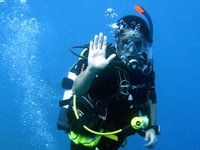I remember as a child my mother cooking with a Pressure-Steamer, I was always fearful the pressure would explode the sealed pot so I often hid away from the sight, what I didn’t realise was the lid had a built in safety device. This is similar to diving in that there is a risk of insignificant nitrogen “Off-Gassing” during our ascents. Diving has primarily always been about Decompression, from day one the concerns of curing or to be more truthful preventing Decompression sickness has always been the leader in Dive accident prevention. Although dive Tables and Computer Models are based on theoretical dive data, there is still some element of risk and the only way to prevent Decompression Sickness is to not dive at all. However there are also Lions in the Jungle, all we can do as educated and safe divers is to ensure these risks are at kept to their minimum.
Avoiding Decompression sickness is to stay hydrated, drink plenty of fluids avoiding alcohol both before and after diving, and using re-hydration salts especially when diving in hotter climates. Avoid strenuous exercise during and after a dive, dive well within recommended limits and ensure both Actual Bottom Time and ascent rates are adhered to. The recommended rate is 18 metres in 60 seconds, with a 5 metre safety stop where applicable. Personally I would recommend a safety stop after ALL dives regardless of whether the RDP (recreational Dive Planner) deems it necessary. With regards to the recommended ascent rate, again I would suggest that slower is better – the way I suggest this is to consider your dive profile as a stepping process – reach your pre-planned depth for the pre-planned time and then stage your ascent to different levels i.e. 26 metres Max Depth for 12 minutes, the next stage would be 18 metres for 4 minutes then 8 metres for 4 minutes then 5 metres for 4 minutes – your ascent rate to each different level of the dive will be both slow and controlled. This example would give you an ascent time from 18 metres of 12 minutes as opposed to the recommended rate of 1 minute. This gives us plenty of time for the nitrogen in your body to “Off-Gas”.
As a responsible diver also ensure you are aware of the emergency action plan and have details of the nearest Hyperbaric Chamber, have contact details for rescue contacts etc. do not rely on others having this information they may be thinking the same about you remember.
Think Moving not Stationary A safety stop, although defined as 5 metres for 3 minutes, can and should be extended where possible consider a 5 metre stop for 8 minutes, you do not have to be stationary! Keep moving to your planned exit point enjoying the wonderful sights at this level and your dive will be both more enjoyable and safer. Often most reefs have an abundance of life and colour at these shallower depths, remember orange and red are the first colours of the light spectrum to disappear as we descend.
Friday, December 8, 2006
Subscribe to:
Post Comments (Atom)



No comments:
Post a Comment